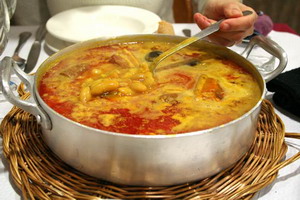Local recipes: Asturian Fabada
by Ana Cuesta
Accommodation
in Asturias
This traditional one-pot
dish from Asturias (North coast of Spain) is dead easy to prepare, the
only tricky parts being perhaps getting the right ingredients (if outside
Asturias) and the need to plan for it ahead of time. A French friend told
me it is similar to their "cassoulet" and Britons get at first surprised
that the beans are savory instead of sweet, but mostly everybody seems
to like it.
The main ingredients are
Fabes (a particular kind of buttery beans with its own protected denomination,
"Faba de la Granja Asturiana"; BTW, the singular is "faba", not "fabe")
and different bits of meat labeled together as "Compango" (companion).
Compango includes Tocino (bacon), Morcilla asturiana (a particular kind
of black pudding; there are upteen types of morcilla all over Spain, but
they can be quite different), Chorizo (a particular kind of sausage) and
often Lacón (pork shoulder). Recipe books generally add onions and
garlic for flavor (they are disposed of after the cooking) and saffron
or paprika for color, but I personally use neither and have never missed
them.
 Now,
while tocino, chorizo and lacón are no problem to find anywhere
in Spain, fabes and morcilla (this particular one) can be far more tricky.
The good news is that, aware of that, Asturian producers now market special
packs with all the ingredients put together and vacuum-packed. These can
be found in regional specialty shops, the gourmet area of big supermarket
chains or over the Internet. Water is also important: use bottled if local
tap water is hard, otherwise the beans will never get cooked! Now,
while tocino, chorizo and lacón are no problem to find anywhere
in Spain, fabes and morcilla (this particular one) can be far more tricky.
The good news is that, aware of that, Asturian producers now market special
packs with all the ingredients put together and vacuum-packed. These can
be found in regional specialty shops, the gourmet area of big supermarket
chains or over the Internet. Water is also important: use bottled if local
tap water is hard, otherwise the beans will never get cooked!
Once we've got all the ingredients,
down to the business:
The night before, leave the
beans soaking in plenty of cold water (they about double/triple their volume)
so they rehydrate and get tender (no hope of getting them cooked in a reasonable
amount of time if this step is skipped). Also leave the lacón soaking
in water, separately, to desalt it (always safer to correct the salt latter).
Some people like to soak all the compango ingredients, even to do it in
hot water, so they lose some greasiness.
Pressure-cooker version:
Discard the water from the soaking. Put the beans in the cooker and add
just enough clean water to cover them. Put the compango on top of the beans.
Close the cooker and bring it to pressure. Once at pressure, let the cooking
go on for 20 minutes. Voila, that's it (I said it was easy, didn't I?).
After opening the cooker, check that the beans are done and correct the
salt. If they are not quite done, cook them a little longer in the open
cooker. The amount of liquid should be just fine, but if too watery you
can always take some beans out, mash them and add them back. Once in a
while, the morcilla blows out under the pressure, so some people prefer
to leave it out of the cooking (after all, it is cooked already) and add
it at the end, once the cooker is open.
Old-fashioned version: Discard
the water from the soaking. Put the beans in the pot, cover them with clean
water and start cooking at low heat with the lid on. From time to time,
add some more water (cold is fine) so the beans keep always covered and
shake the pot gently. Keep doing that regularly (it takes anything between
2 and 3 hours to cook them this way, so patience!). Half way throughout
the cooking, add the compango ingredients (they don't need too long to
cook) and keep to the adding water/shaking routine. Once the beans are
done, check/correct the level of salt and water as above.
To serve the fabada, take
the compango out, cut the different ingredients in small pieces (depending
on the number of servings) and either serve separately or add the pieces
back to the stew. Best served after letting it rest for a while (next day
is even better!). Freezes wonderfully.
This is a rich, pretty fulfilling
dish that doesn't really need anything else apart from bread (putting your
bread on fabada is not only allowed but almost customary) and perhaps a
simple, green salad to clean the palate in between mouthfuls. As for drinks
to accompany it, Asturian cider is probably the best, pretty obvious option
but it also goes well with red wine and perhaps more surprisingly with
cava.
Accommodation
in Asturias / Top
|

